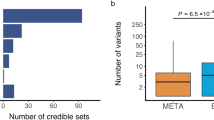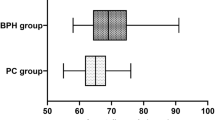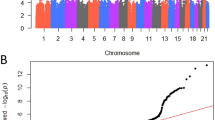Abstract
We investigated the association between seven polymorphisms in four candidate genes involved in vitamin D and androgen metabolism with early-onset prostate cancer (CaP) risk. The polymorphisms were genotyped in 288 UK males who were diagnosed with CaP at the age of 55 y or younger and up to 700 population-based controls. An additional 50 cases (not selected for age) and 76 controls were also genotyped. Short (⩽22 repeats) AR (CAG)n repeats were associated with a significantly reduced risk of early onset CaP (OR 0.68, 95% CI 0.50–0.91) compared with men with long (>22) repeats. Men homozygous for the leucine variant of SRD5A2 p.89V>L were also found to be at a significantly increased risk of CaP compared with men who were homozygous for the valine allele (OR 1.84, 95% CI 1.15–2.98). No associations were found with the AR (GGC)n, CYP17 Msp A1 I, VDR Taq I, SRD5A2 (TA)n and p.49A>T polymorphisms and CaP risk. These findings suggest that common polymorphisms in the AR and SRD5A2 genes may be associated with early-onset CaP in British men.
This is a preview of subscription content, access via your institution
Access options
Subscribe to this journal
Receive 4 print issues and online access
$259.00 per year
only $64.75 per issue
Buy this article
- Purchase on Springer Link
- Instant access to full article PDF
Prices may be subject to local taxes which are calculated during checkout


Similar content being viewed by others
References
Office for National Statistics. Mortality statistics: Cause (Series DH2) No. 29. http://www.statistics.gov.uk; 2002.
American Cancer Society. Cancer facts & figures 2004. http://www.cancer.org; 2004.
Breslow N et al. Latent carcinoma of prostate at autopsy in seven areas. The International Agency for Research on Cancer, Lyons, France. Int J Cancer 1977; 20: 680–688.
Shimizu H et al. Cancers of the prostate and breast among Japanese and white immigrants in Los Angeles County. Br J Cancer 1991; 63: 963–966.
Boring CC, Squires TS, Tong T, Montgomery S . Cancer statistics, 1994. CA Cancer J Clin 1994; 44: 7–26.
Steinberg GD et al. Family history and the risk of prostate cancer. Prostate 1990; 17: 337–347.
Spitz MR et al. Familial patterns of prostate cancer: a case–control analysis. J Urol 1991; 146: 1305–1307.
Carter BS et al. Hereditary prostate cancer: epidemiologic and clinical features. J Urol 1993; 150: 797–802.
Picado-Leonard J, Miller WL . Cloning and sequence of the human gene for P450c17 (steroid 17 alpha-hydroxylase/17,20 lyase): similarity with the gene for P450c21. DNA 1987; 6: 439–448.
Coffey DS. In: Lepor H, Lawson RK (eds). Prostate Diseases. W. B. Saunders, Philadelphia, 1993, pp 28–56.
di Salle E et al. PNU 157706, a novel dual type I and II 5alpha-reductase inhibitor. J Steroid Biochem Mol Biol 1998; 64: 179–186.
Lu S, Tsai SY, Tsai MJ . Regulation of androgen-dependent prostatic cancer cell growth: androgen regulation of CDK2, CDK4, and CKI p16 genes. Cancer Res 1997; 57: 4511–4516.
Peehl DM et al. Antiproliferative effects of 1,25-dihydroxyvitamin D3 on primary cultures of human prostatic cells. Cancer Res 1994; 54: 805–810.
Giovannucci E et al. The CAG repeat within the androgen receptor gene and its relationship to prostate cancer. Proc Natl Acad Sci USA 1997; 94: 3320–3323.
Hakimi JM et al. Androgen receptor variants with short glutamine or glycine repeats may identify unique subpopulations of men with prostate cancer. Clin Cancer Res 1997; 3: 1599–1608.
Ingles SA et al. Association of prostate cancer risk with genetic polymorphisms in vitamin D receptor and androgen receptor. J Natl Cancer Inst 1997; 89: 166–170.
Stanford JL et al. Polymorphic repeats in the androgen receptor gene: molecular markers of prostate cancer risk. Cancer Res 1997; 57: 1194–1198.
Ekman P et al. Links between genetic and environmental factors and prostate cancer risk. Prostate 1999; 39: 262–268.
Hsing AW et al. Polymorphic CAG and GGN repeat lengths in the androgen receptor gene and prostate cancer risk: a population-based case–control study in China. Cancer Res 2000; 60: 5111–5116.
Hardy DO et al. Androgen receptor CAG repeat lengths in prostate cancer: correlation with age of onset. J Clin Endocrinol Metab 1996; 81: 4400–4405.
Bratt O et al. CAG repeat length in the androgen receptor gene is related to age at diagnosis of prostate cancer and response to endocrine therapy, but not to prostate cancer risk. Br J Cancer 1999; 81: 672–676.
Irvine RA, Yu MC, Ross RK, Coetzee GA . The CAG and GGC microsatellites of the androgen receptor gene are in linkage disequilibrium in men with prostate cancer. Cancer Res 1995; 55: 1937–1940.
Edwards SM et al. Androgen receptor polymorphisms: association with prostate cancer risk, relapse and overall survival. Int J Cancer 1999; 84: 458–465.
Carey AH et al. Polycystic ovaries and premature male pattern baldness are associated with one allele of the steroid metabolism gene CYP17. Hum Mol Genet 1994; 3: 1873–1876.
Nedelcheva Kristensen V et al. CYP17 and breast cancer risk: the polymorphism in the 5′ flanking area of the gene does not influence binding to Sp-1. Cancer Res 1999; 59: 2825–2828.
Feigelson HS et al. A polymorphism in the CYP17 gene increases the risk of breast cancer. Cancer Res 1997; 57: 1063–1065.
Huang CS et al. Breast cancer risk associated with genotype polymorphism of the estrogen-metabolizing genes CYP17, CYP1A1, and COMT: a multigenic study on cancer susceptibility. Cancer Res 1999; 59: 4870–4875.
Lunn RM et al. Prostate cancer risk and polymorphism in 17 hydroxylase (CYP17) and steroid reductase (SRD5A2). Carcinogenesis 1999; 20: 1727–1731.
Gsur A et al. A polymorphism in the CYP17 gene is associated with prostate cancer risk. Int J Cancer 2000; 87: 434–437.
Davis DL, Russell DW . Unusual length polymorphism in human steroid 5 alpha-reductase type 2 gene (SRD5A2). Hum Mol Genet 1993; 2: 820.
Kantoff PW et al. A polymorphism of the 5 alpha-reductase gene and its association with prostate cancer: a case-control analysis. Cancer Epidemiol Biomarkers Prev 1997; 6: 189–192.
Hsing AW et al. Polymorphic markers in the SRD5A2 gene and prostate cancer risk: a population-based case-control study. Cancer Epidemiol Biomarkers Prev 2001; 10: 1077–1082.
Latil AG et al. Prostate carcinoma risk and allelic variants of genes involved in androgen biosynthesis and metabolism pathways. Cancer 2001; 92: 1130–1137.
Margiotti K et al. Evidence for an association between the SRD5A2 (type II steroid 5 alpha-reductase) locus and prostate cancer in Italian patients. Dis Markers 2000; 16: 147–150.
Makridakis NM et al. Association of mis-sense substitution in SRD5A2 gene with prostate cancer in African-American and Hispanic men in Los Angeles, USA. Lancet 1999; 354: 975–978.
Jaffe JM et al. Association of SRD5A2 genotype and pathological characteristics of prostate tumors. Cancer Res 2000; 60: 1626–1630.
Mononen N et al. A missense substitution A49T in the steroid 5-alpha-reductase gene (SRD5A2) is not associated with prostate cancer in Finland. Br J Cancer 2001; 84: 1344–1347.
Soderstrom T et al. 5alpha-reductase 2 polymorphisms as risk factors in prostate cancer. Pharmacogenetics 2002; 12: 307–312.
Makridakis N et al. A prevalent missense substitution that modulates activity of prostatic steroid 5alpha-reductase. Cancer Res 1997; 57: 1020–1022.
Febbo PG et al. The V89L polymorphism in the 5alpha-reductase type 2 gene and risk of prostate cancer. Cancer Res 1999; 59: 5878–5881.
Makridakis NM, di Salle E, Reichardt JK . Biochemical and pharmacogenetic dissection of human steroid 5alpha-reductase type II. Pharmacogenetics 2000; 10: 407–413.
Morrison NA et al. Contribution of trans-acting factor alleles to normal physiological variability: vitamin D receptor gene polymorphism and circulating osteocalcin. Proc Natl Acad Sci USA 1992; 89: 6665–6669.
Morrison NA et al. Prediction of bone density from vitamin D receptor alleles. Nature 1994; 367: 284–287.
Correa-Cerro L et al. Vitamin D receptor polymorphisms as markers in prostate cancer. Hum Genet 1999; 105: 281–287.
Blazer III DG et al. Vitamin D receptor polymorphisms and prostate cancer. Mol Carcinog 2000; 27: 18–23.
Taylor JA et al. Association of prostate cancer with vitamin D receptor gene polymorphism. Cancer Res 1996; 56: 4108–4110.
Ingles SA et al. Strength of linkage disequilibrium between two vitamin D receptor markers in five ethnic groups: implications for association studies. Cancer Epidemiol Biomarkers Prev 1997; 6: 93–98.
Ingles SA et al. Association of prostate cancer with vitamin D receptor haplotypes in African-Americans. Cancer Res 1998; 58: 1620–1623.
Eeles RA, Group, t. U. F. P. S. C.-o. & Collaborators, t. C. B. U. F. P. C. S. Genetic predisposition to prostate cancer. Prostate Cancer Prostatic Diseases 1999; 2: 9–15.
Popat S et al. Prevalence of the APC E1317Q variant in colorectal cancer patients. Cancer Lett 2000; 149: 203–206.
Allen NE, Forrest MS, Key TJ . The association between polymorphisms in the CYP17 and 5alpha-reductase(SRD5A2) genes and serum androgen concentrations in men. Cancer Epidemiol Biomarkers Prev 2001; 10: 185–189.
Key TJ et al. A case–control study of diet and prostate cancer. Br J Cancer 1997; 76: 678–687.
Sham PC, Curtis D . Monte Carlo tests for associations between disease and alleles at highly polymorphic loci. Ann Hum Genet 1995; 59: 97–105.
Rebbeck TR et al. Modification of BRCA1-associated breast cancer risk by the polymorphic androgen-receptor CAG repeat. Am J Hum Genet 1999; 64: 1371–1377.
Given HF et al. The androgen receptor exon 1 trinucleotide repeat does not act as a modifier of the age of presentation in breast cancer. Eur J Cancer 2000; 36: 533–534.
Ishikawa S, Soloway MS, Van der Zwaag R, Todd B . Prognostic factors in survival free of progression after androgen deprivation therapy for treatment of prostate cancer. J Urol 1989; 141: 1139–1142.
Prehn RT . On the prevention and therapy of prostate cancer by androgen administration. Cancer Res 1999; 59: 4161–4164.
Thompson IM et al. The influence of finasteride on the development of prostate cancer. N Engl J Med 2003; 349: 215–224.
Schatzl G et al. Serum androgen levels in men: impact of health status and age. Urology 2003; 61: 629–633.
Habuchi T et al. Increased risk of prostate cancer and benign prostatic hyperplasia associated with a CYP17 gene polymorphism with a gene dosage effect. Cancer Res 2000; 60: 5710–5713.
Wadelius M et al. Prostate cancer associated with CYP17 genotype. Pharmacogenetics 1999; 9: 635–639.
Gayther SA et al. The frequency of germ-line mutations in the breast cancer predisposition genes BRCA1 and BRCA2 in familial prostate cancer. The Cancer Research Campaign/British Prostate Group United Kingdom Familial Prostate Cancer Study Collaborators. Cancer Res 2000; 60: 4513–4518.
Carter HB et al. Longitudinal evaluation of prostate-specific antigen levels in men with and without prostate disease. JAMA 1992; 267: 2215–2220.
Author information
Authors and Affiliations
Consortia
Corresponding author
Additional information
Supplementary Information accompanies the paper on Prostate Cancer website (http://www.nature.com/PCAN).
Supplementary information
Rights and permissions
About this article
Cite this article
Forrest, M., Edwards, S., Houlston, R. et al. Association between hormonal genetic polymorphisms and early-onset prostate cancer. Prostate Cancer Prostatic Dis 8, 95–102 (2005). https://doi.org/10.1038/sj.pcan.4500785
Received:
Revised:
Accepted:
Published:
Issue Date:
DOI: https://doi.org/10.1038/sj.pcan.4500785



